Investigation of the Behavior and Mechanism of Action of Ether-Based Polycarboxylate Superplasticizers Adsorption on Large Bibulous Stone Powder
Abstract
:1. Introduction
2. Materials and Methods
2.1. Materials
2.2. Polycarboxylate (PCE) Adsorption via Total Organic Carbon (TOC)
2.3. Characterization
2.3.1. Pore Size Distribution
2.3.2. Fourier-Transform Infrared Spectroscopy (FTIR)
2.3.3. Thermogravimetric Analysis (TGA)
2.4. Zeta Potential Measurements
2.5. Hydrodynamic Diameter Distribution
3. Results and Discussion
3.1. Adsorption Kinetics of PCE-1 on Stone Powder
3.2. Isothermal Adsorption of PCE onto Large Bibulous Stone Powder (LBSP)
3.3. The Influence of pH and PCE Concentration on the Zeta Potential of LBSP
3.4. Characterization of the PCE/LBSP Compound
4. Conclusions
Author Contributions
Funding
Institutional Review Board Statement
Informed Consent Statement
Data Availability Statement
Acknowledgments
Conflicts of Interest
References
- Li, Z.; Meng, X.; Zhou, Y.; Xia, J.; Chen, H.; Li, K. Research on the characteristic and mechanism of high water absorption aggregate in East Africa. Concrete 2018, 342, 95–97. (In Chinese) [Google Scholar]
- Li, X.-K.; Zheng, D.-F.; Zheng, T.; Lin, X.-L.; Lou, H.-M.; Qiu, X.-Q. Enhancement Clay Tolerance of PCE by Lignin-Based Polyoxyethylene Ether in Montmorillonite-Contained Paste. J. Ind. Eng. Chem. 2017, 49, 168–175. [Google Scholar] [CrossRef]
- Flatt, R.; Schober, I. Superplasticizers and the Rheology of Concrete. In Understanding the Rheology of Concrete; Elsevier: Amsterdam, The Netherlands, 2012; pp. 144–208. [Google Scholar]
- Plank, J.; Pöllmann, K.; Zouaoui, N.; Andres, P.R.; Schaefer, C. Synthesis and Performance of Methacrylic Ester Based Polycarboxylate Superplasticizers Possessing Hydroxy Terminated Poly(Ethylene Glycol) Side Chains. Cem. Concr. Res. 2008, 38, 1210–1216. [Google Scholar] [CrossRef]
- Xu, Q.; Gao, H.; Zeng, J.; Chen, C.; Zhou, W.; Wang, S.; Tian, X.; Peng, Y. Synthesis, Working Mechanism, and Effectiveness of a Novel Corrosion-Inhibiting Polycarboxylate Superplasticizer for Concrete. Can. J. Chem. Eng. 2016, 94, 1909–1917. [Google Scholar] [CrossRef]
- Yoshioka, K.; Tazawa, E.-I.; Kawai, K.; Enohata, T. Adsorption Characteristics of Superplasticizers on Cement Component Minerals. Cem. Concr. Res. 2002, 32, 1507–1513. [Google Scholar] [CrossRef]
- Plank, J.; Liu, C.; Ng, S. Interaction between clays and polycarboxylate superplasticizers in cementitious systems. GDCh-Monographie 2010, 42, 349–356. [Google Scholar]
- Borralleras, P.; Segura, I.; Aranda, M.A.G.; Aguado, A. Absorption Conformations in the Intercalation Process of Polycarboxylate Ether Based Superplasticizers into Montmorillonite Clay. Constr. Build. Mater. 2020, 236, 116657. [Google Scholar] [CrossRef]
- Ng, S.; Plank, J. Interaction mechanisms between Na montmorillonite clay and MPEG-based polycarboxylate superplasticizers. Cem. Concr. Res. 2012, 42, 847–854. [Google Scholar] [CrossRef]
- Sakai, E.; Atarashi, D.; Daimon, M. Interaction between superplasticizers and clay minerals. In Proceedings of the 6th International Symposium on Cement & Concrete, Beijing, China, 1 January 2006. [Google Scholar]
- Lei, L.; Plank, J. A concept for a polycarboxylate superplasticizer possessing enhanced clay tolerance. Cem. Concr. Res. 2012, 42, 1299–1306. [Google Scholar] [CrossRef]
- Lei, L.; Plank, J. Synthesis and properties of a vinyl ether-based polycarboxylate superplasticizer for concrete possessing clay tolerance. Ind. Eng. Chem. Res. 2014, 53, 1048–1055. [Google Scholar] [CrossRef]
- Liu, X.; Guan, J.; Lai, G.; Zheng, Y.; Wang, Z.; Cui, S.; Lan, M.; Li, H. Novel designs of polycarboxylate superplasticizers for improving resistance in clay-contaminated concrete. J. Ind. Eng. Chem. 2017, 55, 80–90. [Google Scholar] [CrossRef]
- Li, Y.; Zheng, X.; Wu, K.; Lu, M. Synthesis of amphiphilic polycarboxylate copolymer and its notable dispersion and adsorption characteristics onto cement and clay. Adv. Cem. Res. 2016, 28, 344–353. [Google Scholar] [CrossRef]
- Chen, G.; Lei, J.; Du, Y.; Chen, X. Synthesis of a novel polycarboxylate superplasticizer with carboxyl group as side chain terminal group to enhance its clay tolerance. Wuhan Univ. Technol. Mater. Sci. Ed. 2018, 33, 226–232. [Google Scholar] [CrossRef]
- Werani, M.; Lei, L. Influence of Side Chain Length of MPEG—Based Polycarboxylate Superplasticizers on Their Resistance towards Intercalation into Clay Structures. Constr. Build. Mater. 2021, 281, 122621. [Google Scholar] [CrossRef]
- Felekoglu, B. Utilisation of High Volumes of Limestone Quarry Wastes in Concrete Industry (Self-Compacting Concrete Case). Resour. Conserv. Recycl. 2007, 51, 770–791. [Google Scholar] [CrossRef]
- Ahmadi, B.; Shekarchi, M. Use of Natural Zeolite as a Supplementary Cementitious Material. Cem. Concr. Compos. 2010, 32, 134–141. [Google Scholar] [CrossRef]
- Li, H.; Wang, Z.; Sun, R.; Huang, F.; Yi, Z.; Yuan, Z.; Wen, J.; Lu, L.; Yang, Z. Effect of Different Lithological Stone Powders on Properties of Cementitious Materials. J. Clean. Prod. 2021, 289, 125820. [Google Scholar] [CrossRef]
- Feng, L.; Chen, X.; Cheng, Z.; Wen, X. Quantitative Analysis for Adsorption of Polycarboxylate Superplasticizer with Different Side-Chain Length on Tuff Powder Using Second Derivative Spectrometr. Spectrosc. Spectr. Anal. 2019, 39, 2788–2793. (In Chinese) [Google Scholar]
- Feng, H.; Pan, L.; Zheng, Q.; Li, J.; Xu, N.; Pang, S. Effects of Molecular Structure of Polycarboxylate Superplasticizers on Their Dispersion and Adsorption Behavior in Cement Paste with Two Kinds of Stone Powder. Constr. Build. Mater. 2018, 170, 182–192. [Google Scholar] [CrossRef]
- Zheng, T.; Zheng, D.; Qiu, X.; Yang, D.; Fan, L.; Zheng, J. A Novel Branched Claw-Shape Lignin-Based Polycarboxylate Superplasticizer: Preparation, Performance and Mechanism. Cem. Concr. Res. 2019, 119, 89–101. [Google Scholar] [CrossRef]
- Feneuil, B.; Pitois, O.; Roussel, N. Effect of surfactants on the yield stress of cement paste. Cem. Concr. Res. 2017, 100, 32–39. [Google Scholar] [CrossRef] [Green Version]
- Wang, W.; Zheng, B.; Feng, Z.; Deng, Z.; Fu, L. Adsorption of polycarboxylate-based superplasticizer onto natural bentonite. J. Adv. Concr. Technol. 2012, 10, 323–331. [Google Scholar] [CrossRef] [Green Version]
- Karagozoglu, B.; Tasdemir, M.; Demirbas, E.; Kobya, M. The adsorption of basic dye (Astrazon Blue FGRL) from aqueous solutions onto sepiolite, fly ash and apricot shell activated carbon: Kinetic and equilibrium studies. J. Hazard. Mater. 2007, 147, 297–306. [Google Scholar] [CrossRef] [PubMed]
- Bulut, E.; Özacar, M.; Şengil, İ.A. Adsorption of malachite green onto bentonite: Equilibrium and kinetic studies and process design. Microporous Mesoporous Mater. 2008, 115, 234–246. [Google Scholar] [CrossRef]
- Wang, L.; Gao, C.; Feng, J.; Xu, Y.; Li, D.; Zhang, L. Adsorption Properties of Comb-Shaped Polycarboxylate Dispersant onto Different Crystal Pyraclostrobin Particle Surfaces. Materials 2020, 25, 5637. [Google Scholar]
- Plank, J.; Hirsch, C. Impact of Zeta Potential of Early Cement Hydration Phases on Superplasticizer Adsorption. Cem. Concr. Res. 2007, 37, 537–542. [Google Scholar] [CrossRef]
- Zingg, A.; Winnefeld, F.; Holzer, L.; Pakusch, J.; Becker, S.; Gauckler, L. Adsorption of Polyelectrolytes and Its Influence on the Rheology, Zeta Potential, and Microstructure of Various Cement and Hydrate Phases. J. Colloid Interface Sci. 2008, 323, 301–312. [Google Scholar] [CrossRef]
- Plank, J.; Sachsenhauser, B. Experimental Determination of the Effective Anionic Charge Density of Polycarboxylate Superplasticizers in Cement Pore Solution. Cem. Concr. Res. 2009, 39, 1–5. [Google Scholar] [CrossRef]
- Ait-Akbour, R.; Boustingorry, P.; Leroux, F.; Leising, F.; Taviot-Guého, C. Adsorption of PolyCarboxylate Poly(Ethylene Glycol) (PCP) Esters on Montmorillonite (Mmt): Effect of Exchangeable Cations (Na+, Mg2+ and Ca2+) and PCP Molecular Structure. J. Colloid Interface Sci. 2015, 437, 227–234. [Google Scholar] [CrossRef]
- Tan, H.; Gu, B.; Ma, B.; Li, X.; Lin, C.; Li, X. Mechanism of Intercalation of Polycarboxylate Superplasticizer into Montmorillonite. Appl. Clay Sci. 2016, 129, 40–46. [Google Scholar] [CrossRef]
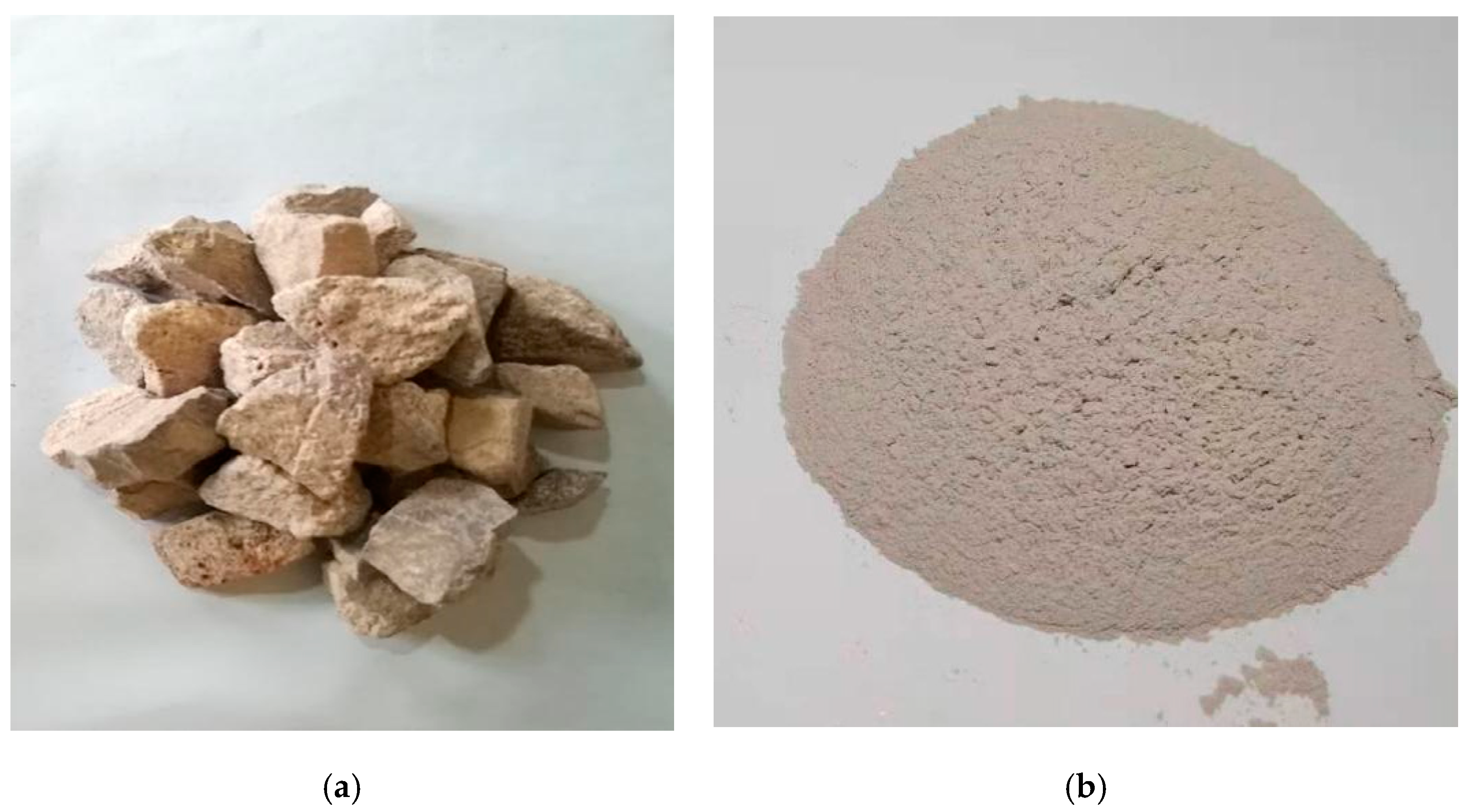



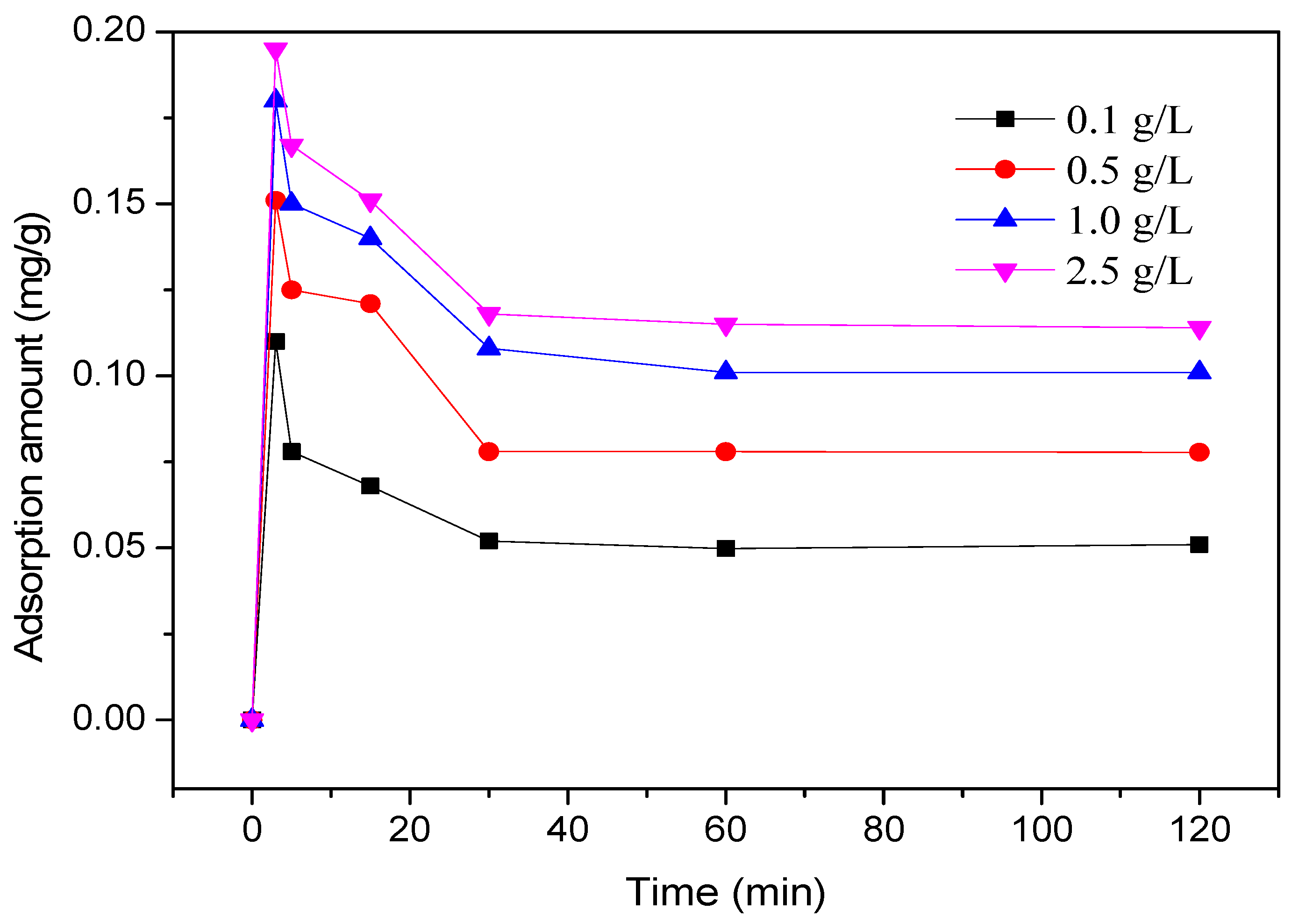

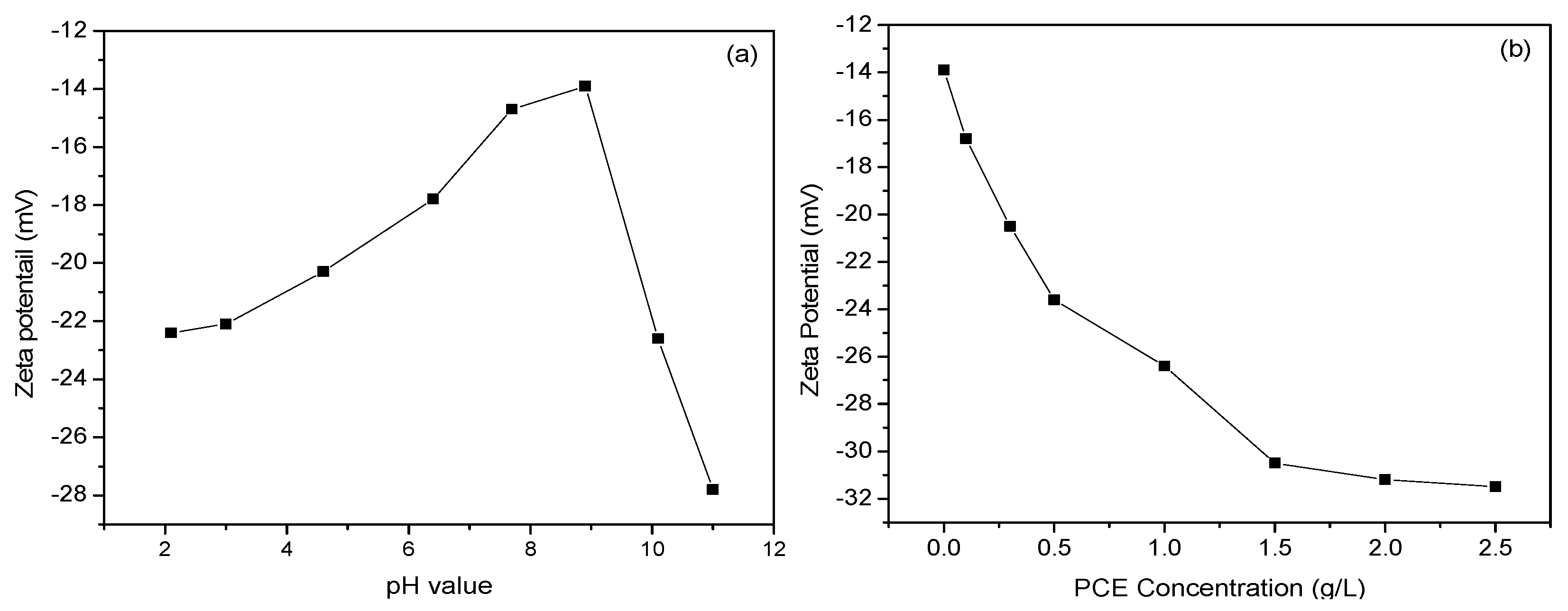
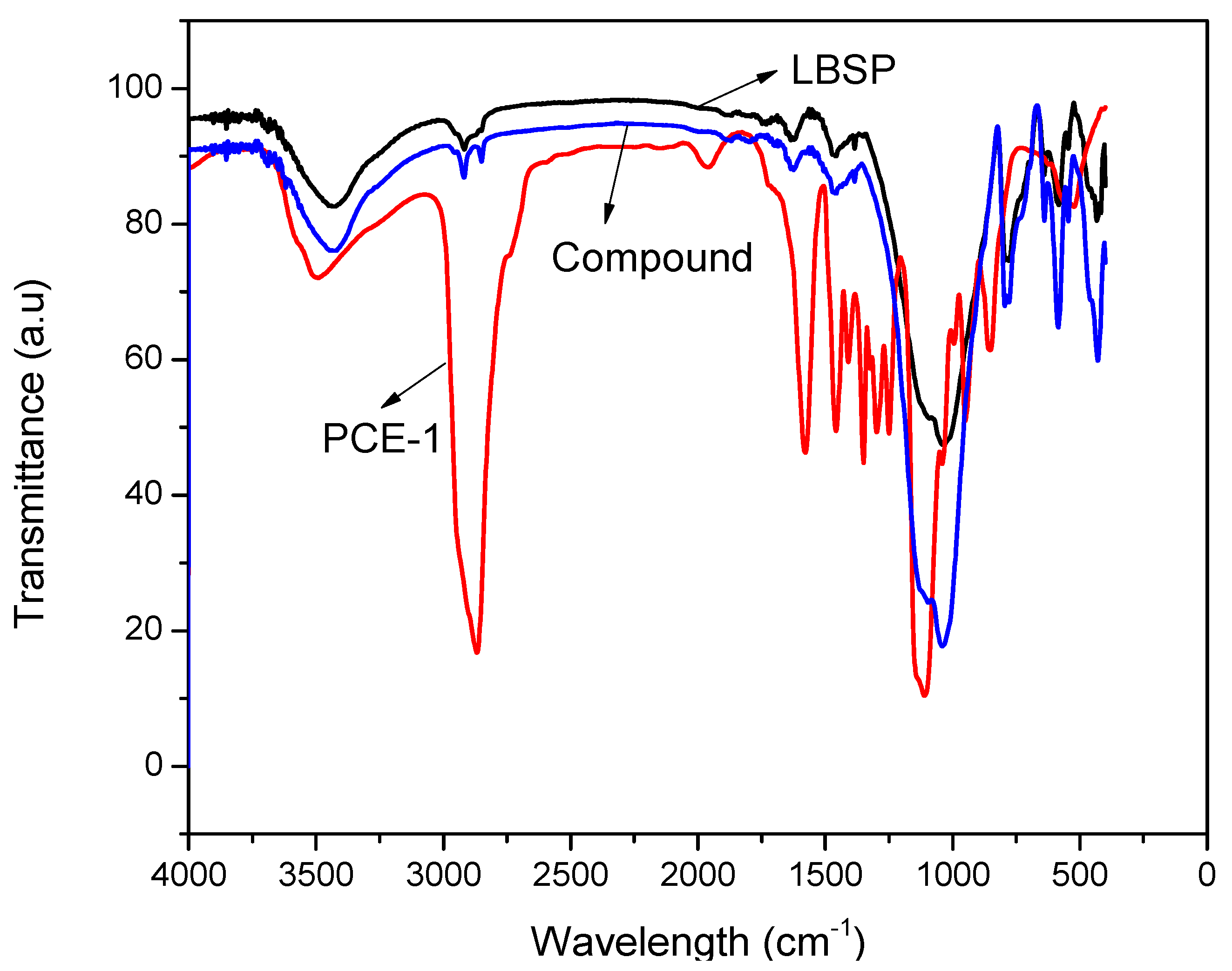


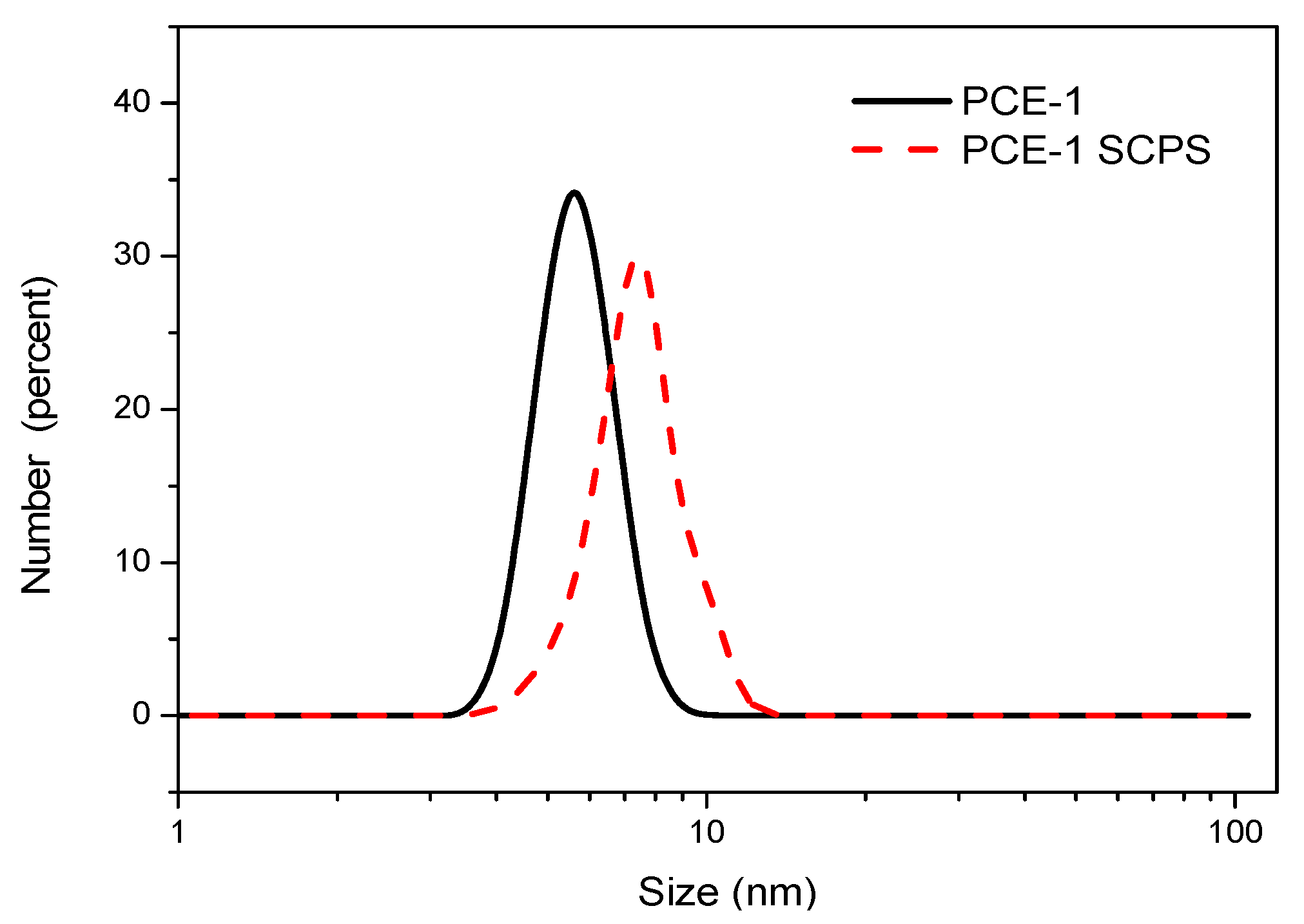
| Chemical Composition (wt%) | ||||||||||||
|---|---|---|---|---|---|---|---|---|---|---|---|---|
| SiO2 | Al2O3 | Fe2O3 | Na2O | CaO | TiO2 | BaO | ZrO2 | SO3 | Br | MgO | MnO | P2O5 |
| 67.22 | 13.25 | 5.17 | 2.18 | 1.20 | 0.33 | 0.14 | 0.13 | 0.12 | 0.08 | 0.06 | 0.06 | 0.04 |
| Sample | Length of Side Chain (nEO) | Side Chain Density (a:b) | Mn (g/mol) | Mw (g/mol) | Polydispersity Index (Mw/Mn) | Solid Content (wt%) |
|---|---|---|---|---|---|---|
| PCE-1 | 54 | 3.2:1 | 18,600 | 34,800 | 1.87 | 50.0 |
| Temperature/K | Kc(×10–3) | ΔG/(kJ/mol) | ΔH/(J/mol) | ΔS/(J/(K·mol)) |
|---|---|---|---|---|
| 293 | 0.351 | 13.77 | 19.47 | 19.52 |
| 303 | 0.458 | 13.57 | ||
| 313 | 0.585 | 13.38 |
| Powder Type | BET Surface Area/m²/g | Average Pore Diameter /nm | BJH Volume of Pores in 1.7–30 nm/1*10−3 cm³/g | Adsorption Surface Area of Pores in 1.7–30 nm/cm2/g |
|---|---|---|---|---|
| Stone powder | 4.58 | 21.7 | 8.474 | 0.749 |
| Compound | 1.55 | 6.6 | 0.792 | 0.262 |
Publisher’s Note: MDPI stays neutral with regard to jurisdictional claims in published maps and institutional affiliations. |
© 2021 by the authors. Licensee MDPI, Basel, Switzerland. This article is an open access article distributed under the terms and conditions of the Creative Commons Attribution (CC BY) license (https://creativecommons.org/licenses/by/4.0/).
Share and Cite
Deng, Z.; Lu, G.; Fu, L.; Wang, W.; Zheng, B. Investigation of the Behavior and Mechanism of Action of Ether-Based Polycarboxylate Superplasticizers Adsorption on Large Bibulous Stone Powder. Materials 2021, 14, 2736. https://doi.org/10.3390/ma14112736
Deng Z, Lu G, Fu L, Wang W, Zheng B. Investigation of the Behavior and Mechanism of Action of Ether-Based Polycarboxylate Superplasticizers Adsorption on Large Bibulous Stone Powder. Materials. 2021; 14(11):2736. https://doi.org/10.3390/ma14112736
Chicago/Turabian StyleDeng, Zuiliang, Guimin Lu, Lefeng Fu, Weishan Wang, and Baicun Zheng. 2021. "Investigation of the Behavior and Mechanism of Action of Ether-Based Polycarboxylate Superplasticizers Adsorption on Large Bibulous Stone Powder" Materials 14, no. 11: 2736. https://doi.org/10.3390/ma14112736
APA StyleDeng, Z., Lu, G., Fu, L., Wang, W., & Zheng, B. (2021). Investigation of the Behavior and Mechanism of Action of Ether-Based Polycarboxylate Superplasticizers Adsorption on Large Bibulous Stone Powder. Materials, 14(11), 2736. https://doi.org/10.3390/ma14112736





